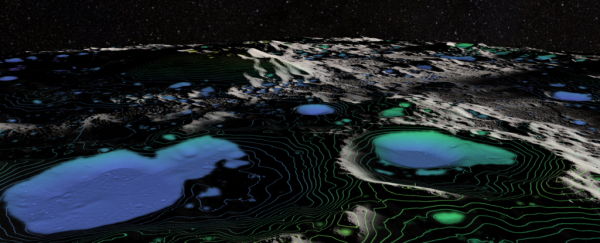It's official. There's water on the Moon.
We've thought that there was for over a decade, based on detections described back in 2009, but there was room for interpretation in the wavelengths used. Now, using a different wavelength unique to water, scientists report the first unambiguous detection.
Those 2009 conclusions were apparently on the money.
The ambiguity arose because the 2009 detections were made in the 3-micrometre infrared band. At this wavelength, there were two possibilities - water, or another hydroxyl compound comprising hydrogen and oxygen.
Led by astronomer Casey Honniball of the NASA Goddard Space Flight Centre, a team of scientists decided to look into the wavelength that could confirm or overturn those findings. The 6-micrometre infrared band should show a line that can only be created by two hydrogen atoms and one oxygen atom - what is called the H-O-H bend vibration.
But actually making an unambiguous detection in that band is tricky. It requires the use of the Stratospheric Observatory for Infrared Astronomy (SOFIA), a special, one-of-a-kind telescope that is flown in a plane above the bulk of Earth's atmosphere.
"SOFIA is the only current and planned observatory capable of these observations," Honniball told ScienceAlert.
"Current lunar spacecraft do not have instruments that can measure at 6 micrometres, and from the ground, Earth's atmosphere blocks 6-micron light, and so it cannot be done from ground-based observatories. SOFIA flies above 99.9 percent of the Earth's water vapour, which allows 6-micrometre light to pass through and be observed. And luckily SOFIA's FORCAST instrument can make 6-micrometre measurements and look at the Moon."
Using FORCAST, the team carefully studied a region in which the 3-micrometre detections had been made - high southern latitudes, around the south pole. There, they found the emission line they had been hoping for - that unique signature that could only be created by the H-O-H bend vibration.
Based on their detections, the team estimates water abundances of around 100 to 400 parts per million - consistent with 3-micrometre detections made by the Moon Mineralogy Mapper.
Of course, there are no liquid lakes sloshing around on the lunar surface, and any frozen water would sublimate as soon as the sunlight hit it. But there are multiple ways the Moon could still be harbouring surface water.
"We mainly think the water is in glass," Honniball said.
"When a micrometeorite impacts the Moon, it melts some lunar material, which quickly cools and forms a glass. If there is water already present, formed during or delivered during the impact, some of the water can be captured in the structure of the glass while it cooled."
In a separate paper led by astronomer Paul Hayne of the University of Colorado Boulder, scientists explored another possibility - regions of permanent shadow in polar craters. At high latitudes, high crater rims create regions that sunlight never touches.
In these spots, temperatures never reach above approximately -163 degrees Celsius (-260 degrees Fahrenheit), creating cold traps that could harbour hidden patches of water ice.
Using data from NASA's Lunar Reconnaissance Orbiter, Hayne and his colleagues calculated that there could be as much as 40,000 square kilometres (15,000 square miles) of such permanently shadowed surface. And 60 percent of that is at the south pole.
"The temperatures are so low in cold traps that ice would behave like a rock," Hayne said. "If water gets in there, it's not going anywhere for a billion years."
Both papers have very important implications for future lunar missions. NASA is planning to establish a lunar base as part of the Artemis mission; if an abundant source of water can be found nearby, lunar residents could make use of it for drinking, for growing crops, even splitting it using electrolysis to obtain hydrogen for rocket fuel.
But we need to get a better picture of where the water might be, and how much is there. The work of Haynes' team will help work out where to look; the work of Honniball's team gives us the how. All we need now is the telescope time.
"We have been granted two more hours on SOFIA and are requesting an additional 72 hours," Honniball said. "With more observations we will be able to characterise the behaviour of water across the lunar surface and understand its source, where it resides, and if it moves around the lunar surface."
Both papers have been published in Nature Astronomy. They can be found here and here.
